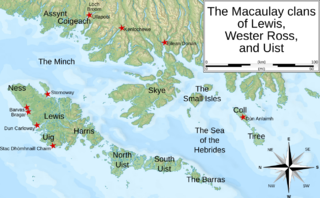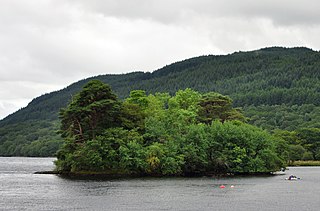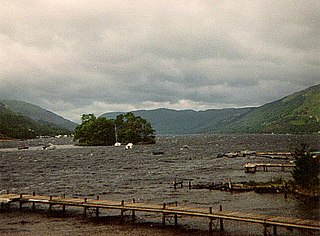

It is recorded that in 1490 James IV of Scotland ordered Lord Drummond to cast down the house of the Ester (eastern) Isle of Loch Ern (Neish Island) and destroy all the strengths of the same and take away the boat and put it at the Wester (western) Isle. [1] The Neishes apparently had the only boat on the loch and although the dwelling was demolished the Neishes repaired it and continued to live there, occupying most of the land near St Fillans and as far west as Tyndrum. [1] The Neishes apparently took refuge on the island after being defeated by the Clan Macnab at the Battle of Glenboultachan in 1522. [2] The Neishes or MacNeishes are regarded as a sept of the Clan Gregor. [3] In a later part of the feud, in 1612, when the Neishes robbed the Macnabs, the Macnabs apparently took revenge by attacking the Neishes on the island, all of whom were killed except for one small boy who hid under a bed and from who all of the name Neish are allegedly descended. [2] According to the New Statistical Account of Scotland there is a tradition that the Neishes or Nishes felt that they were safe from reprisals on the island because they had the only boat on the loch, but the Macnabs went to the effort of carrying their own boat on their shoulders and over the Grampian Mountains to get to the island. [4] The Neishes had a small castle on the island and the ruins of it still remain, and the remnants of a little boat abandoned by the Macnabs on their way back over the hills were still seen into the early part of the 20th Century. [5] [6] The castle on the island consisted of a square keep, divided into chambers and constructed with thick walls. [7] A small harbour and landing place for boats still exists on the east side of the island. [7]

Clan Donnachaidh, also known as Clan Robertson, is a Scottish clan.

Argyll, sometimes called Argyllshire, is a historic county and registration county of western Scotland.

Clan Donald, also known as Clan MacDonald, is a Highland Scottish clan and one of the largest Scottish clans. The Lord Lyon King of Arms, who is the Scottish official with responsibility for regulating heraldry in that country, issuing new grants of coats of arms, and serving as the judge of the Court of the Lord Lyon, recognizes under Scottish law the High Chief of Clan Donald. Historically the chiefs of the Clan Donald held the title of Lord of the Isles until 1493 and two of those chiefs also held the title of Earl of Ross until 1476.

Clan MacLean is a Highlands Scottish clan. They are one of the oldest clans in the Highlands and owned large tracts of land in Argyll as well as the Inner Hebrides. Many early MacLeans became famous for their honour, strength and courage in battle. They were involved in clan skirmishes with the Mackinnons, Camerons, MacDonalds and Campbells, as well as all of the Jacobite risings.

Clan Maclaine of Lochbuie is a Scottish Clan that inhabited lands on the southern end of the Isle of Mull in the Inner Hebrides of the western Scottish Highlands. "Maclaine" is an alternate spelling for "McLean." Clan Maclaine of Lochbuie and Clan Maclean of Duart are two separate clans. However, the two clans share a strong family connection. The 26th clan chief is The Much Honoured Lorne Gillean Ian Maclaine of Lochbuie, Baron of Moy. The clan is recognized by both the Standing Council of Scottish Chiefs and the Lord Lyon.

Loch Shiel is a freshwater loch situated 20 kilometres (12 mi) west of Fort William in the Highland council area of Scotland. At 28 kilometres long it is the 4th longest loch in Scotland, and is the longest to have retained a natural outflow without any regulation of its water level, being 120 m (393 ft) deep. Its nature changes considerably along its length, being deep and enclosed by mountains in the north east and shallow surrounded by bog and rough pasture in the south west, from which end the 4 km River Shiel drains to the sea in Loch Moidart near Castle Tioram.

Clan Mackintosh is a Scottish clan from Inverness in the Scottish Highlands. The chiefs of the clan are the Mackintoshes of Mackintosh. Another branch of the clan, the Mackintoshes of Torcastle, are the chiefs of Clan Chattan, a historic confederation of clans.

The Battle of the Shirts was a Scottish clan battle that took place in 1544 in the Great Glen, at the northern end of Loch Lochy. The Clan Macdonald of Clanranald and their allies the Clan Cameron fought the Clan Fraser and men from Clan Grant. The battlefield has been included and protected by Historic Scotland in their Inventory of Historic Battlefields in Scotland.

Clan MacKinnon or Clan Fingon is a Highland Scottish clan associated with the islands of Mull and Skye, in the Inner Hebrides.

Killin (; is a village situated at the western head of Loch Tay in the central highlands of Scotland. The village is administered by the Stirling council area but is more closely tied to the historic county of Perthshire, Scotland. Killin is a historic conservation village and sits within the Loch Lomond and The Trossachs National Park.It is the central settlement of the historic region of Breadalbane.

Lochearnhead is a village on the A84 Stirling to Crianlarich road at the foot of Glen Ogle, 14 miles north of the Highland Boundary Fault. It is situated at the western end of Loch Earn where the A85 road from Crieff meets the A84.

Clan Macnab is a Highland Scottish clan.

Clan Matheson is a Highland Scottish clan.

The Macaulay family of Uig in Lewis, known in Scottish Gaelic as Clann mhic Amhlaigh, were a small family located around Uig on the Isle of Lewis in the Outer Hebrides of Scotland. There is no connection between the Macaulays of Lewis and Clan MacAulay which was centred in the Loch Lomond area, bordering the Scottish Highlands and Scottish Lowlands. The Macaulays of Lewis are generally said to be of Norse origin because of the etymology of their surname and also because of the islands' Viking Age past. However, a recent analysis of the Y-DNA of men with Scottish surnames has shown that a large number of Hebridean Macaulays are of Irish origin. In the 17th century, however, tradition gave the Macaulays an Irish origin. By the end of the 16th century the dominant clan on Lewis was Clan Macleod of The Lewes. Other notable Lewis clans were the somewhat smaller Morrisons of Ness and the even less numerous Macaulays of Uig. The Macaulays were centred in the area surrounding Uig on the western coast of Lewis, and had a deadly, long-standing feud with the Morrisons, whose lands were located on the northern coast around Ness. Today the Lewis surname Macaulay is considered to be a sept name of the Macleods of Lewis. There are two other nearby clans of Macaulays who may, or may not, be connected to the Lewis clan—the Wester Ross Macaulays, and the Uist MacAulays.

Innischonnell is an island in Loch Awe, Scotland. It is part of Kilchrenan and Dalavich parish, in Argyll. The island is fourteen miles east of Kilmartin, Argyll.

Waternish or Vaternish is a peninsula approximately 12 kilometres long on the island of Skye, Scotland, situated between Loch Dunvegan and Loch Snizort in the northwest of the island, and originally inhabited and owned by Clan MacNeacail/MacNicol/Nicolsons.

Inveruglas Isle is a small uninhabited island within Loch Lomond, and lies off the shore at Inveruglas opposite Inversnaid at the north end of the loch. It is opposite the Loch Sloy powerstation.

The Stand-off at the Ford of Arkaig occurred in September 1665 at Achnacarry, about 10 miles (16 km) northeast of Fort William, Scotland. The Chattan Confederation led by the Clan Mackintosh assembled an army to challenge Clan Cameron in a 360-year-old dispute over the lands around Loch Arkaig. After a week of stalemate, the long-running feud was ended by a deal in which the Camerons bought the land from the Mackintoshes.

Lochalsh is a district of mainland Scotland that is currently part of the Highland council area. It is a hilly peninsula that lies between Loch Carron and Loch Alsh. The main settlement is Kyle of Lochalsh, located at the entrance to Loch Alsh, opposite the village of Kyleakin on the adjacent island of Skye. A ferry used to connect the two settlements but was replaced by the Skye Bridge in 1995.

The Battle of Glenboultachan was a Scottish clan battle fought in 1522 in Glen Boultachan, Perthshire, Scottish Highlands. It was fought between the Clan Macnab and the Clan Neish or MacNeish. The Macnabs won the battle.
|journal= (help)| Wikimedia Commons has media related to Neish Island . |
Coordinates: 56°23′32″N4°7′18″W / 56.39222°N 4.12167°W